Published
on 6
Oct 2006
|
All rights reserved.
|
|
|
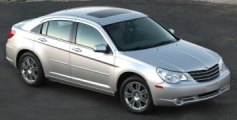 It
looks like a Crossfire coupe converted to a 4-door sedan. This
impression mainly comes from the grooved bonnet and the familiar grille
and headlights, but unfortunately, elsewhere of the car looks nothing
like a coupe. In fact, it looks quite bulky and conservative, blame to
the tall profile, long roofline and slow-angle windshield / rear
window. Few people will buy this car for look. It
looks like a Crossfire coupe converted to a 4-door sedan. This
impression mainly comes from the grooved bonnet and the familiar grille
and headlights, but unfortunately, elsewhere of the car looks nothing
like a coupe. In fact, it looks quite bulky and conservative, blame to
the tall profile, long roofline and slow-angle windshield / rear
window. Few people will buy this car for look.
Well, we don't have any expectation for the new Sebring. Remember the
last generation Sebring? it sold 1.3 million copies from 2001 to 2006,
but the only thing its owners would remember is its very low price. The
new car is likely to fall into a similar position. Look at its cabin
and you will understand: today, even GM and Ford have ceased producing
a dashboard so cheap. It is said to be a big improvement from the old
Sebring, but that only reflects how bad the old car was. When compare
with its key rival, Toyota Camry, the Chrysler mid-size family car is
at least 3 classes lower in material quality and assembly tolerance.
Besides, I suppose no one will like the design of the dashboard. Now I
understand why Chrysler is negotiating with China's Chery to jointly
develop and build their next small cars, because the Chinese just might
build better interior than Chrysler itself !
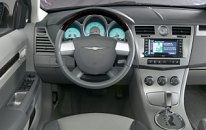 At least there are enough space
in the cabin, if no more than rivals. With 2765mm wheelbase, there is
good legroom for all passengers. Although the occupants sit 65mm higher
than the old car to give a "commanding view" like SUVs do, headroom is
compensated by the 1499mm height. Nevertheless, the back seat is
difficult to squeeze in 3 average-size adults because the cabin is a
little narrow - a reflection that it is derived from a small car
platform (we shall talk about that later). The short boot swallows only
385 liters of luggage, well below class standard. At least there are enough space
in the cabin, if no more than rivals. With 2765mm wheelbase, there is
good legroom for all passengers. Although the occupants sit 65mm higher
than the old car to give a "commanding view" like SUVs do, headroom is
compensated by the 1499mm height. Nevertheless, the back seat is
difficult to squeeze in 3 average-size adults because the cabin is a
little narrow - a reflection that it is derived from a small car
platform (we shall talk about that later). The short boot swallows only
385 liters of luggage, well below class standard.
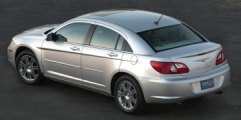 What the Chrysler better than
rivals are some gadgets (though many are pay options), such as a 20GB
harddisk for storing MP3 songs, an AUX input for i-Pod, Bluetooth
connectivity, a voice-activated audio system, a heating / cooling cup
holder and a folding front passenger seat. Rivals can easily get
similar equipment from the same suppliers, so these gadgets are not
actually an advantage to the Chrysler. What I concern most is the
fundamental of the car - the chassis, the powertrain etc. These are the
elements that characterize the car and won't be copied easily by others. What the Chrysler better than
rivals are some gadgets (though many are pay options), such as a 20GB
harddisk for storing MP3 songs, an AUX input for i-Pod, Bluetooth
connectivity, a voice-activated audio system, a heating / cooling cup
holder and a folding front passenger seat. Rivals can easily get
similar equipment from the same suppliers, so these gadgets are not
actually an advantage to the Chrysler. What I concern most is the
fundamental of the car - the chassis, the powertrain etc. These are the
elements that characterize the car and won't be copied easily by others.
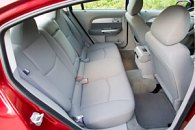 The Sebring is built on a
platform jointly developed with Mitsubishi. It was primarily designed
for Mitsubishi Lancer and Dodge Caliber but there is no reason why it
cannot work well in the mid-size Sebring. Volkswagen also developed
Passat from the Golf platform, so successful or not depends on the
components it uses and the tuning it gets. Scanning the spec sheet,
there is nothing wrong with the Sebring. It gets struts and multi-link
suspensions. Its chassis rigidity is 170 percent higher than its
predecessor's. On the road, the stiffness and NVH suppression is
competitive. Thanks to a comfort-biased suspension setup, the standard
Sebring rides quite smoothly on regular roads. However, this soft
setting plus the high center of gravity result in poor handling. In
tight corners the Sebring rolls a lot and feels clumsy to handle. The
top model with 3.5-liter V6 is better, thanks to a stiffer suspension
setup. However, no Sebring is going to delight keen drivers. Its power
steering lacks both weighting and feel. Its braking - standard car
employs a laughable drum brakes at rear wheels - is simply poor. The Sebring is built on a
platform jointly developed with Mitsubishi. It was primarily designed
for Mitsubishi Lancer and Dodge Caliber but there is no reason why it
cannot work well in the mid-size Sebring. Volkswagen also developed
Passat from the Golf platform, so successful or not depends on the
components it uses and the tuning it gets. Scanning the spec sheet,
there is nothing wrong with the Sebring. It gets struts and multi-link
suspensions. Its chassis rigidity is 170 percent higher than its
predecessor's. On the road, the stiffness and NVH suppression is
competitive. Thanks to a comfort-biased suspension setup, the standard
Sebring rides quite smoothly on regular roads. However, this soft
setting plus the high center of gravity result in poor handling. In
tight corners the Sebring rolls a lot and feels clumsy to handle. The
top model with 3.5-liter V6 is better, thanks to a stiffer suspension
setup. However, no Sebring is going to delight keen drivers. Its power
steering lacks both weighting and feel. Its braking - standard car
employs a laughable drum brakes at rear wheels - is simply poor.
Base
engine is the 2.4-liter 16V "World Engine" jointly developed with
Mitsubishi and Hyundai. But don't confuse "World Engine" with
"world-class engine". Despite of the twin-balancer shafts, it sounds
coarse at high rev and never runs as smoothly as Japanese's offerings.
Despite of the sophisticated dual continuous VVT and two-stage intake
manifolds, it doesn't feel as powerful as the output figures 173hp and
166lbft suggested. Part of this sluggish response is due to the
use of a 4-speed automatic. There is no 5-speed auto or manual gearbox
on offer.
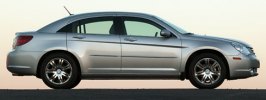 Above the four-cylinder engine
is Chrysler's long-serving 2.7-liter DOHC 24-valve V6 and 3.5-liter
SOHC 24-valve V6. Frankly speaking, they have passed their time and
should have been retired. Power output are unremarkable 189hp and 235hp
respectively, way below the Japanese and Korean's 260-plus level. The
2.7 V6 again comes with the old-fashion 4-speed automatic gearbox as
the only choice. The 3.5 V6 mates with a better, if slightly
unresponsive, 6-speed automatic. Predictably, all Sebrings are slow. Above the four-cylinder engine
is Chrysler's long-serving 2.7-liter DOHC 24-valve V6 and 3.5-liter
SOHC 24-valve V6. Frankly speaking, they have passed their time and
should have been retired. Power output are unremarkable 189hp and 235hp
respectively, way below the Japanese and Korean's 260-plus level. The
2.7 V6 again comes with the old-fashion 4-speed automatic gearbox as
the only choice. The 3.5 V6 mates with a better, if slightly
unresponsive, 6-speed automatic. Predictably, all Sebrings are slow.
The new Sebring lacks both driver appeal and refinement to compete with
Japanese mid-size sedans and Ford Fusion. It even lacks a good look -
the traditional strength of Chrysler since the days its design
department led by Tom Gale. After Caliber, this is another
disappointing product from the American company.
|
Verdict:   |
Published
on 14
Feb 2007
|
All rights reserved.
|
|
Dodge Avenger
|
|
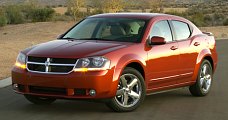 When
you redress a poor car with ugly clothes, it will only become a poorer
car. This is the case for Dodge Avenger. Chrysler's management
childishly believed that American patriots will buy the idea of a
"mini-Dodge Charger", so they restyled the Sebring's C-pillar and
pumped up the muscles over its rear wheelarches. At the front, the nose
is squared up and incorporates a big cross grille like any Dodge trucks
and SUVs. The result is the ugliest new car we saw in 2006. Poor taste. When
you redress a poor car with ugly clothes, it will only become a poorer
car. This is the case for Dodge Avenger. Chrysler's management
childishly believed that American patriots will buy the idea of a
"mini-Dodge Charger", so they restyled the Sebring's C-pillar and
pumped up the muscles over its rear wheelarches. At the front, the nose
is squared up and incorporates a big cross grille like any Dodge trucks
and SUVs. The result is the ugliest new car we saw in 2006. Poor taste.
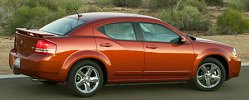 Underneath the clothes is the
same car as Sebring, which scored only 2 stars in our AutoZine rating
last year. It still comes with a cheap interior, numb steering,
mediocre four and six cylinder engines and a handling handicapped by
the tall body. In the Dodge Avenger, however, there is a sportier model
called "R/T" on offer. It gets stiffer suspension setup to claw back
some scores in handling without hurting ride quality much, but the
overall handling is still poorer than the inherently better engineered
Ford Fusion, Saturn Aura, Volkswagen Passat, Honda Accord, Nissan
Altima etc. The R/T has no upgrade in power though – still the 235hp
3.5 V6 and 6-speed auto like the top Sebring. Performance does not live
up to the expectation for its "Road / Track" badge. Underneath the clothes is the
same car as Sebring, which scored only 2 stars in our AutoZine rating
last year. It still comes with a cheap interior, numb steering,
mediocre four and six cylinder engines and a handling handicapped by
the tall body. In the Dodge Avenger, however, there is a sportier model
called "R/T" on offer. It gets stiffer suspension setup to claw back
some scores in handling without hurting ride quality much, but the
overall handling is still poorer than the inherently better engineered
Ford Fusion, Saturn Aura, Volkswagen Passat, Honda Accord, Nissan
Altima etc. The R/T has no upgrade in power though – still the 235hp
3.5 V6 and 6-speed auto like the top Sebring. Performance does not live
up to the expectation for its "Road / Track" badge.
Ridiculously, Chrysler group wants to sell this car in Europe. It will
need some luck, or rather miracles, to attract sufficient sales.
|
Verdict:   |
Published
on 24
Apr 2007
|
All rights reserved.
|
|
Sebring Convertible
|
|
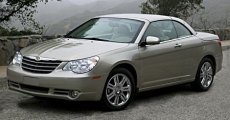 Handsome,
roomy and very cheap were the three reasons that made the last
generation Chrysler Sebring Convertible the best selling convertible in
America for many years. Chrysler want to repeat the same successful
story in the third generation car, of course, but this time it won't be
so easy. First of all, the new Sebring Convertible is as ugly as its
sedan sister, although it implements the ugliness in different way. An
angular profile with a long long tail looks both unbalanced and bulky.
Second, starting from $26,000 for the base model to $34,500 for a top
model with retractable hard top, it is no longer as bargain as before.
You can have Pontiac G6 Convertible and Volkswagen Eos for less money,
or add a few thousands to upgrade to Volvo C70. Handsome,
roomy and very cheap were the three reasons that made the last
generation Chrysler Sebring Convertible the best selling convertible in
America for many years. Chrysler want to repeat the same successful
story in the third generation car, of course, but this time it won't be
so easy. First of all, the new Sebring Convertible is as ugly as its
sedan sister, although it implements the ugliness in different way. An
angular profile with a long long tail looks both unbalanced and bulky.
Second, starting from $26,000 for the base model to $34,500 for a top
model with retractable hard top, it is no longer as bargain as before.
You can have Pontiac G6 Convertible and Volkswagen Eos for less money,
or add a few thousands to upgrade to Volvo C70.
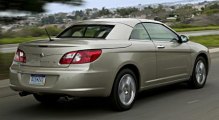 Space-wise, the Chrysler
convertible is still a real 4-passenger convertible. Its rear seats can
accommodate regular size passengers like Volvo C70, but it is no longer
as spacious as before owing to the demise of "cab forward" design and
the addition of the complicated roof mechanism behind the rear seats.
The roof mechanism and the chassis reinforcement also added 200
kilograms to the car, making the base 173hp 2.4-liter four-pot suffers,
the mid-range 189hp 2.7-liter V6 struggles and the top 235hp 3.5-liter
V6 barely adequate. I would be surprised if the latter can do 0-60 mph
in less than 8 seconds. Space-wise, the Chrysler
convertible is still a real 4-passenger convertible. Its rear seats can
accommodate regular size passengers like Volvo C70, but it is no longer
as spacious as before owing to the demise of "cab forward" design and
the addition of the complicated roof mechanism behind the rear seats.
The roof mechanism and the chassis reinforcement also added 200
kilograms to the car, making the base 173hp 2.4-liter four-pot suffers,
the mid-range 189hp 2.7-liter V6 struggles and the top 235hp 3.5-liter
V6 barely adequate. I would be surprised if the latter can do 0-60 mph
in less than 8 seconds.
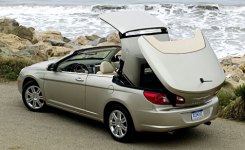 Fortunately, the additional
weight are well spent to enhance refinement and convenience. Chrysler
claims this chassis is 2.5 times stiffer in torsion than the old car,
and it shows on the road. There is very little chassis scuttle shake
with or without the roof opened. The cabin is generally quiet and free
of turbulence. Such a high level of refinement must be a surprised to
an American car. Pontiac G6, for example, is not as refined as this
one. The automatic roof mechanism is equally trouble-free, thanks to
the engineering job done by German convertible specialist Karmann,
which also supplies the roof. Fortunately, the additional
weight are well spent to enhance refinement and convenience. Chrysler
claims this chassis is 2.5 times stiffer in torsion than the old car,
and it shows on the road. There is very little chassis scuttle shake
with or without the roof opened. The cabin is generally quiet and free
of turbulence. Such a high level of refinement must be a surprised to
an American car. Pontiac G6, for example, is not as refined as this
one. The automatic roof mechanism is equally trouble-free, thanks to
the engineering job done by German convertible specialist Karmann,
which also supplies the roof.
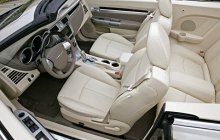 One thing is silly though: this
car offers 3 kinds of roof for selection – retractable metal roof (the
most expensive), fabric roof (middle price) and vinyl soft roof (the
cheapest), with different noise and thermal insulation capability, of
course. More silly, all three use the same actuating mechanism, so the
soft tops take the same boot space as the hard top when closed. This
leave only 200 liters at the boot. It seems likely that the car was
designed to use retractable metal roof exclusively from the outset, but
after calculated the price and found it would be too expensive, it
added the cheaper choices to push down the base price. One thing is silly though: this
car offers 3 kinds of roof for selection – retractable metal roof (the
most expensive), fabric roof (middle price) and vinyl soft roof (the
cheapest), with different noise and thermal insulation capability, of
course. More silly, all three use the same actuating mechanism, so the
soft tops take the same boot space as the hard top when closed. This
leave only 200 liters at the boot. It seems likely that the car was
designed to use retractable metal roof exclusively from the outset, but
after calculated the price and found it would be too expensive, it
added the cheaper choices to push down the base price.
Predictably,
Sebring Convertible does not aim to be a sporty car. Its foundation is
unremarkable, its suspensions are set soft and its steering remains
effortless and lifeless. The weight burden also makes swift cornering
impossible. However, the refinement and comfortable ride make it a good
motorway cruiser, which is open-air motoring all about. In this
respect, the old car had never been so good.
|
Verdict:    |
Published
on 16
Jan 2011
|
All rights reserved.
|
|
Chrysler 200 and Dodge Avenger (2011)
|
|
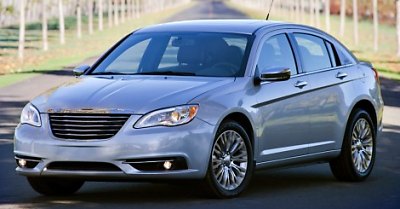 Sebring gets its second chance
Sebring gets its second chance
Like most of you, I have
never been enthusiastic about the outgoing Chrysler Sebring. In my
original report written four years ago, it was seriously criticized in
many aspects – in particular, performance, handling, styling and cabin
quality. Few cars got such a poor reputation at first launch, and even
fewer cars could be credited for making its maker bankrupted.
Naturally, the reborn Chrysler does not want to hear this name again,
so it has been renamed to Chrysler 200, which goes in line with the
larger 300. Apart from a new name, the car got revised clothes. Biggest
change is the front end, which sports a new grille and new headlights.
Do they make the car more stylish ? yes, but just. Turn your vision
towards the side and you will see much the same boring Sebring. Despite
of a drop of ride height, the car still appears to be too tall and
narrow, lacking the fluidity of Ford Mondeo or Hyundai Sonata. At the
back, new LED taillights and redesigned trunk lid lift the style a
little. However, like the front grille, they lack character.
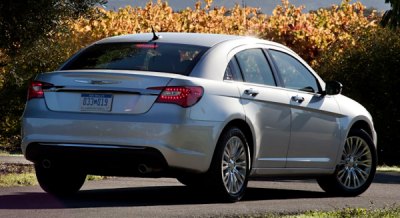 More stylish here but lacks character
More stylish here but lacks character
Inside, the cabin gets a new
dashboard. Style is not its strength, because it has to settle on the
old car's dash structure. What really impresses is the materials
covering this structure – thanks God, hard shinny plastics have been
replaced with soft-touch ones, and the greyness of the old dashboard
gives place to chrome accents and piano-black surfaces, even though the
analogue clock is too pretentious to be luxury… you won't confuse it
with a Maserati.
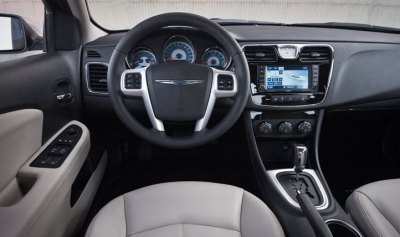 You won't confuse that analogue clock
with Maserati's.
You won't confuse that analogue clock
with Maserati's.
In the mechanical side, the most obvious change is of course the use of
new Pentastar V6. This 3.6-liter DVVT unit pumps out a remarkable 283
horsepower, finally giving the car competitive performance. 0-60 mph
should take about 6.5 seconds. On the flip side, it is rather thirsty,
especially when compare against the latest Hyundai Sonata 2.0T. As a
result, when it goes on sale in Europe next year (under the name Lancia
Flavia) it will probably skip the V6 and adopt a FIAT turbo diesel
engine instead. For now, the economy engine is the unchanged 2.4-liter
four with 173hp. It cries for more power and better fuel efficiency.
Don't expect FIAT's Multiair technology to arrive any time soon.
Dodge Avenger
Sister car Dodge Avenger gets basically the same mechanical
modifications in 2011. Difference from Chrysler still lies on
packaging. Its face is barely changed, which means it is still an ugly
duck. The interior is similar to Chrysler but without the silly clock
and lacquer treatment. |
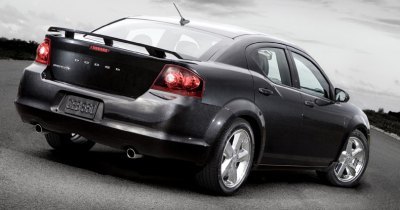 Dodge Avenger is still an ugly duck
Dodge Avenger is still an ugly duck
To sort out its poor handling,
Chrysler widened its tracks and lowered its suspensions a little bit,
stiffened its springs and anti-roll bars, adopted stiffer front
suspension bushings and a quicker steering rack. On the road, the 200
is more alive. Compare with the Sebring it rolls less in corners and
turns in more keenly. However, you will never call it agile. Not only
by European standard, but by the standard of its Japanese and Korean
rivals fitted with sport suspensions, this American car is bulky to
handle. It does not contain its body roll and understeer as good as
others. Moreover, its steering, though quicker in response, remains
feeless. The only feel is the torque steer when you push the Pentastar
engine too hard. Apparently, the modifications made are not enough to
mask the fundamental flaws of its platform.
You might say
Chrysler has done an admirable job in just one year to convert the
Sebring into 200. Even so, it is not going to earn more than two stars
from a maximum five, because from any perspective the 200 is still
below class average.
|
Verdict:    |
Published
on 30
Jan 2011
|
All rights reserved.
|
|
200 Convertible
|
|
As Chrysler Sebring becomes 200, Sebring Convertible is also updated to
200 Convertible. The basis is the same as the sedan, which means
improvement majors on higher quality interior, more refined chassis
tuning and new Pentastar V6. The roof mechanism of the Convertible,
however, is unchanged. As before, it offers the strange choices of both
fabric soft roof and retractable metal roof, though the third choice,
i.e. the cheapest vinyl soft roof, has been ditched in the view of
little customer interest.
The old convertible was already a heavy car. Now having received all
these upgrade of build quality, insulation and refinement, it becomes
even heavier. Fortunately, the new V6 is more than enough to
compensate, and the retuned suspension copes better with the weight,
resulting in decent performance and acceptable handling. The base
2.4-liter engine is not as lucky, so you'd better to avoid it.
As before, the 200 convertible is the only true 4-seat open-top car at
affordable price. Its rear seats are more spacious than Volvo C70 and
Volkswagen Eos, while its price undercuts the premium BMW 3-series
Cabriolet by a comfortable margin. Quality or dynamic-wise, it is
hardly memorable. Taking money into account, it is still worth some
consideration. At least, it is now a more decent choice than the old
car.
|
Verdict:   |
|